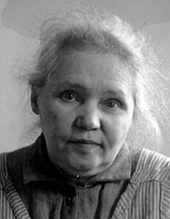Search for Names, Places and Biographies
Already layed Stumbling Stones
Suche
Anna Krebs * 1874
Colonnaden 54 (Hamburg-Mitte, Neustadt)
HIER WOHNTE
ANNA KREBS
JG. 1874
EINGEWIESEN 1904
HEILANSTALT LANGENHORN
"VERLEGT" 9.4.1943
HEILANSTALT
MESERITZ-OBRAWALDE
ERMORDET 1.9.1943
Anna Krebs, born on 17 Sept. 1874 in Halberstadt, transferred on 9 Apr. 1943 from the Langenhorn "sanatorium and nursing home” ("Heil- und Pflegeanstalt" Langenhorn) to the Meseritz-Obrawalde killing center, murdered there on 1 Sept. 1943
Colonnaden 54
Anna Krebs was born on 17 Sept. 1874 in Halberstadt. She belonged to the Lutheran Church, was confirmed, and worked as a domestic servant and cook after her school days. On 14 Nov. 1898, she arrived in Hamburg to go "into service” there. According to her own information, the parents were no longer alive at that time. Her mother Johanna, née Krebs, is said to have drowned herself when Anna was 16 years old. Her father, Friedrich Krebs, worked as a bricklayer in Halberstadt.
Anna Krebs had been employed in Emilie Schmidtke’s household at Colonnaden 54 only for a few days when she was admitted to St. Georg Hospital because of "melancholia” and from there to the Friedrichsberg State Hospital (Staatskrankenanstalt), at that time still called a "lunatic asylum,” on 12 Sept. 1901.
During the admission procedure, she complained of headaches and dizziness, was in a "depressed mood,” said that there was no help left for her, and that she wanted to "go into the Alster” river.
The clinical picture of her "psychosis” did not improve. As time went by, she noticed that she was suffering from hallucinations and heard her grandmother’s voice. A guardian was appointed for Anna Krebs to attend to her affairs.
On 6 Dec. 1904, she was transferred to the Langenhorn State Hospital with the diagnosis "dementia” at the request of the Dienstbotenkrankenkasse, the health insurance company for domestics, and at the expense of poor relief services (Allgemeine Armenanstalt). Upon her arrival, she was calm and friendly, as well as oriented with respect to time and place. When asked why she had come to Friedrichsberg, she replied, "The nerves were shattered.” In an intelligence test, she calculated remarkably quickly and correctly. Anna Krebs was employed in the institution with light housework and in the peeling kitchen, worked very diligently, was agreeable, and did not pay attention to her environment.
In 1927, her patient’s file indicated the medical prognosis that she was in an "advanced stage of feeblemindedness” ("vorgeschritten schwachsinnig”) and needed further institutional treatment.
On 21 May 1928, Anna Krebs was transferred to the Lippische Heil- und Pflegeanstalt Lindenhaus, a sanatorium and nursing home in Brake near Lemgo, due to overcrowding of the institution. There, too, she was busy peeling potatoes and doing light housework. When knitting, she did "her thing quite well,” but she was inaccessible to any contact. Often she talked to herself quietly; otherwise, she did not attract any attention. Her transfer back to Langenhorn took place on 10 Sept. 1930.
In Sept. 1932, the diagnosis was "schizophrenia final stage,” and although she came from the medical to the nursing department within the institution in November, Anna Krebs continued to peel potatoes. At the beginning of 1933, she became somewhat more lively again, gave correct answers to questions, but assumed titles such as "Countess” and "Empress” or quoted offhand: "Love and the blue sky tent, that’s the most beautiful thing in the world.” Anna Krebs’s mental health hardly changed, but she remained an easily controllable and willing patient, as was noted in her file in 1935.
In Aug. 1940, the institutional management filled out for Anna Krebs the registration form of "Operation T4” ("Aktion T4”), named after the Berlin "euthanasia” headquarters at Tiergartenstrasse 4. The negative assessment was that Anna Krebs received no visitors, accomplished very little, and suffered from confused delusions and dementia. After the official cessation of the "euthanasia” murders following public protests in Aug. 1941, a new wave of relocations of mentally ill and disabled people considered "unworthy of life” ("lebensunwert”) began. By then, the state hospital, meanwhile renamed Langenhorn "sanatorium and nursing home” ("Heil- und Pflegeanstalt” Langenhorn), served as an intermediate institution and collection point.
Anna Krebs, still described in Jan. 1943 as a quiet, modest, and always friendly patient who, although hallucinating, appeared to be orderly on the outside, was taken to the external Meseritz-Obrawalde killing center on 9 Apr. 1943. The chances of survival in the "sanatorium,” originally built in 1904 as a provincial hospital, depended on the work performance and integration of the patients into the institution. The selection was carried out by the medical director, Theophil Mootz, and the institutional physician, Hilde Wernicke. Overdosed drugs such as morphine, scopolamine, Barbital (Veronal), and Hexobarbital (Evipan) were used for targeted killing. A natural cause of death would then be reported to the responsible records office. Officially, Anna Krebs died on 1 Sept. 1943, shortly before her sixty-ninth birthday, of "old age.”
Translator: Erwin Fink
Kindly supported by the Hermann Reemtsma Stiftung, Hamburg.
Stand: May 2020
© Susanne Rosendahl
Quellen: StaH 352-8/7 Staatskrankenanstalt Langenhorn Abl. 1/1995 Nr. 1501; Patientenakte aus der ehemaligen Landesheilanstalt Meseritz-Obrawalde, Akten-Nr. 2043; Wunder: Karriere, S. 118–119; Wunder: Transporte, S. 377–382.


